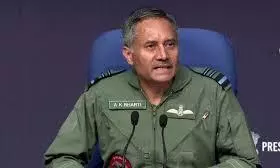
India asserts full operational readiness of military bases, debunks strike claims
text_fieldsIndia has reaffirmed that all its military bases remain fully operational and capable of responding to any future threats, countering recent claims by Pakistan of successful strikes on Indian installations.
Air Vice Marshal (AVM) AK Bharti, Director General of Air Operations, emphasised that the country's defence systems are on high alert and prepared to undertake missions as required.
Speaking at a press briefing, AVM Bharti highlighted the strength of India’s multi-layered, integrated air defence (AD) system, which he credited with effectively shielding both military and civilian infrastructure from potential threats. “Our battle-tested systems have consistently proven their reliability,” he stated, specifically commending the performance of the indigenously developed Akash missile system.
The air defence network comprises layered systems contributed by all three branches of the armed forces — Army, Navy, and Air Force — forming a comprehensive, multi-tier shield.
Inner layer: Short-range systems like Counter Unmanned Aerial Systems (C-UAS), L70 and ZSU 23 Shilka air defence guns, and Man Portable Air Defence Systems (MANPADS).
Mid-layer: Medium-range systems such as the Pechora, Akash Surface-to-Air Missiles, and Medium Range Surface-to-Air Missiles (MRSAM).
Outer layer: Long-range assets, including air defence fighter aircraft and systems like the S-400 missile system.
The structure supports both “soft kill” methods, such as jamming hostile systems, and “hard kill” responses, which involve physically neutralising threats through kinetic action, such as shooting down enemy drones or missiles.
The Integrated Air Command and Control System (IACCS) — developed by the Indian Air Force — serves as the nerve center of the country's air defence network. According to AVM Bharti, IACCS delivers a "net-centric operational capability", which is crucial for coordinating modern military responses.
Originally proposed after the 1999 Kargil conflict and established in 2003, the IACCS links radars and surveillance systems like AWACS, fighter jets, and drones across the Army, Navy, Air Force, and civil aviation. The system provides a real-time Recognised Air Situation Picture (RASP) by analysing data from various radar networks, enabling the swift deployment of the most suitable defence assets based on the type and range of threat.
AVM Bharti credited sustained policy and budgetary support over the past decade for enabling India to operationalise such a comprehensive air defence infrastructure.






